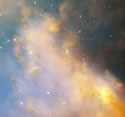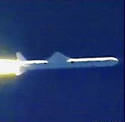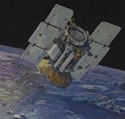NASA investigators have come up with several theories of what could have caused the destruction of the space shuttle Columbia. They’re currently considering whether a block of ice formed on the shuttle’s wing while it was in space. This could have broken off during re-entry and damaged the spacecraft. Another theory suggests that the shuttle collided with a piece of orbital debris.
Hubble Reveals Dumbbell Nebula

Image credit: Hubble
The latest image from the Hubble Space Telescope reveals a close-up view of planetary nebula M29, aka the Dumbbell Nebula. Featured in the image are knots of gas and dust which astronomers believe appear in all planetary nebula at a certain stage of their creation.
An aging star’s last hurrah is creating a flurry of glowing knots of gas that appear to be streaking through space in this close-up image of the Dumbbell Nebula, taken with NASA’s Hubble Space Telescope.
The Dumbbell, a nearby planetary nebula residing more than 1,200 light-years away, is the result of an old star that has shed its outer layers in a glowing display of color. The nebula, also known as Messier 27 (M27), was the first planetary nebula ever discovered. French astronomer Charles Messier spotted it in 1764.
The Hubble images of the Dumbbell show many knots, but their shapes vary. Some look like fingers pointing at the central star, located just off the upper left of the image; others are isolated clouds, with or without tails. Their sizes typically range from 11 – 35 billion miles (17 – 56 billion kilometers), which is several times larger than the distance from the Sun to Pluto. Each contains as much mass as three Earths.
The knots are forming at the interface between the hot (ionized) and cool (neutral) portion of the nebula. This area of temperature differentiation moves outward from the central star as the nebula evolves. In the Dumbbell astronomers are seeing the knots soon after this hot gas passed by.
Dense knots of gas and dust seem to be a natural part of the evolution of planetary nebulae. They form in the early stages, and their shape changes as the nebula expands. Similar knots have been discovered in other nearby planetary nebulae that are all part of the same evolutionary scheme. They can be seen in Hubble telescope photos of the Ring Nebula (NGC 6720), the Eskimo Nebula (NGC 2392) and the Retina Nebula (IC 4406). The detection of these knots in all the nearby planetaries imaged by the Hubble telescope allows astronomers to hypothesize that knots may be a feature common in all planetary nebulae.
This image, created by the Hubble Heritage Team (STScI), was taken by Hubble’s Wide Field Planetary Camera 2 in November 2001, by Bob O’Dell (Vanderbilt University) and collaborators. The filters used to create this color image show oxygen in blue, hydrogen in green and a combination of sulfur and nitrogen emission in red.
Original Source: Hubble News Release
My Condolences
I just wanted to take a moment and offer my deep and sincere condolences to everyone who was touched by the recent space shuttle tragedy. I had the opportunity to watch portions of the ceremony on NASA TV today (yes, through the Internet), and it filled me with sadness for the heroes who died on Saturday. My thoughts have been on almost nothing else for the past few days, so today kind of felt like closure.
I’m glad that a common theme from the government and NASA has been a renewed commitment to the exploration of space, and I was encouraged by the fact that the NASA budget was largely maintained for the coming year. I think NASA did a much better job of responding to the crisis this time, and I really hope they get to the bottom of what happened. Even though they can’t undo what happened, they can make damn sure it never happens again.
On their newly redesigned website, NASA is maintaining ongoing updates and news about their investigation into the tragedy. Even though we’re all deluged by news of the event in many directions, I would encourage you to check out their site to get the scoop. (http://www.nasa.gov)
Take care,
Fraser Cain
Publisher, Universe Today
Book Review: The Life and Death of Planet Earth

I never thought a book about astrobiology could be depressing, but when I put down The Life and Death of Planet Earth by Peter D. Ward and Donald Brownlee, I couldn’t help but feel kind of glum.
Over the course of nearly 300 pages, Ward and Brownlee take a look at our planet and its inhabitants. They chart the Earth’s formation, the catastrophic events that shaped its history, and the rise of life, and finally the evolution of higher life forms. This is familiar territory that they covered in more depth in their previous book, Rare Earth. If you stopped reading here, it would be a happy book.
But there’s lots more to read. They then go on to predict what the future holds for our planet. Whether it will end in fire or ice? Apparently both… and worse. In case you didn’t know, we’re probably enjoying a warm siesta between severe ice ages. And while there are cold times ahead they will eventually end. Our Sun is steadily increasing in temperature – and as the temperatures rise, the biologic diversity on Earth will shrink (it’s possible that we’ve already gone past the height of life’s diversity and we’re already on the slide down). Eventually higher life forms won’t be able to survive, then the plants will go, and finally, hardy heat-loving bacteria living in the highest mountains at the Poles will be driven to extinction and the Earth will be a lifeless, dead world. Then the Sun will enter the final stages of its life, balloon out past the orbit of the Earth, and consume our planet in a fiery afterthought.
Like I said, depressing. But don’t worry, we’ve got a few hundred million years left to enjoy our planet before we’re driven off it as a species.
Ward and Brownlee tell an engaging story, and I was pretty hooked from beginning to end. There’s lots of scientific terminology, but it’s always well explained – easy reading for almost anyone. At each point they stop to describe our future world, they step away from the science and just tell you what you’d see if you looked around. It was very easy to imagine what it must be like to stand on a sun-parched landscape and see our descendants struggling to survive.
The Life and Death of Planet Earth isn’t without hope, though. There are plans afoot to change the Earth’s orbit by engineering near misses by asteroids – hopefully this could set our planet on an outward spiral that always keeps us in the right distance to enjoy a temperate environment. They encourage ongoing research into space exploration as a way to avoid our ultimate fate.
I’m hoping Ward and Brownlee will continue on this path for another book, and maybe paint a portrait of how the Universe will end. After all the galaxies have drifted apart; after all the stars have decayed and turned into white dwarfs or black holes; after black holes have consumed all the matter there is; and after the black holes themselves have evaporated, leaving us with a Universe of elementary particles accelerating away from each other into the darkness.
Have a nice day. 🙂
Cargo Ship Docks with Space Station

Image credit: NASA
A Russian-built Progress cargo ship docked with the International Space Station on Tuesday, bringing food and supplies to the three-astronaut crew. Since the space shuttles have been grounded after the disaster, the astronauts will depend on these ships in the coming months. A manned flight is scheduled for April or May to relieve them.
A Russian Progress 10 resupply craft successfully docked to the International Space Station today, two days after it was launched from the Baikonur Cosmodrome in Kazakhstan.
The cargo ship linked up to the aft port of the Zvezda Service Module at 8:49 a.m. CST (1449 GMT) following a flawless automated approach to the complex. The Progress is carrying a ton of food, fuel and supplies for the Expedition 6 crew on board the ISS. At the time of docking, the ISS was flying 240 statute miles over central Asia.
Expedition 6 Commander Ken Bowersox, Flight Engineer Nikolai Budarin and NASA ISS Science Officer Don Pettit monitored the docking of the Progress from inside the station in their 73rd day in space, their 71st day on board the orbital outpost.
The station crewmembers planned to open the hatch between Zvezda and the Progress around 1:00 p.m. CST (1900 GMT) following leak checks between the two craft, but its supplies will not be unloaded until Wednesday morning. The successful arrival of the Progress assures that the three station residents will have plenty of supplies to continue their mission until late June or early July, if required.
Among the supplies in the new Progress are replacement parts for the Microgravity Science Glovebox in the Destiny laboratory, which experienced a power failure back in November and has been dormant during Expedition 6. Pettit plans to install the new parts and test the Glovebox Wednesday. If it works, the Glovebox will be used to support all of the experiments planned for this Expedition before the crew returns to Earth in March.
Bowersox, Budarin and Pettit will pay a private tribute on orbit today to Columbia?s astronauts. Station flight controllers will radio to the crew an audio feed from the memorial ceremony at the Johnson Space Center in Houston, TX, which is being attended by President Bush and Mrs. Bush, and NASA Administrator Sean O?Keefe.
Original Source: NASA News Release
Inquiry Uncovers More Clues to Shuttle Disaster
NASA engineers have uncovered more clues about the destruction of the space shuttle Columbia. According to sensors, the shuttle was being pulled to the left by increased drag on its wing. Small jets that maintain the shuttle’s direction were attempting to compensate, but weren’t able to overcome the forces turning it to the side. Engineers are also investigating how a dislodged chunk of insulating foam could have damaged the shuttle’s heat tiles, but it seems increasingly unlikely that it could have struck with enough force to cause any harm.
Bush Attends Columbia Memorial
Thousands of workers, friends and family held a memorial today in Houston say farewell to the seven astronauts who died Saturday morning when the space shuttle Columbia broke up above Texas. Amid memorial speechs, Bush vowed that “America’s space program will go on,” confirming the agency’s resolve to continue space exploration. The memorial ended with the ringing of a Navy bell, once for each astronaut, and then a “missing man” formation of fighter jets.
Space Shuttle Columbia Destroyed, Crew Feared Lost
NASA controllers lost contact with the space shuttle Columbia around 1400 GMT (9:00am EST) somewhere over the Dallas/Fort Worth area of Texas – only 15 minutes before it was scheduled to land in Florida. The seven astronaut crew are feared lost as large chunks of debris have been seen raining over the area. NASA controllers had no warning that there was a problem, and are currently working to uncover what happened. So far, there is no suspicion of terrorism.
NASA is planning press conferences on Saturday to release more details.
Pegasus Rocket Launches NASA SORCE Satellite

Image credit: NASA
A Pegasus XL rocket successfully launched NASA’s SORCE satellite on Saturday afternoon. The Pegasus was released from its Stargazer L-1011 carrier aircraft at an altitude of nearly 12,000 metres, and it then ignited and flew the satellite into orbit. SORCE contains five instruments designed to observe the Sun.
NASA’s Solar Radiation and Climate Experiment (SORCE) successfully launched Saturday aboard a Pegasus XL rocket.
“Saturday’s successful launch adds to our constellation of Earth-viewing satellites that help us to understand and protect our home planet,” said Dr. Ghassem Asrar, NASA’s Associate Administrator for Earth Sciences, Washington.
“We are all tremendously excited about whatby what we will learn about the solar climate connection from SORCE,” said Bill Ochs, SORCE Project Manager at NASA’s Goddard Space Flight Center in Greenbelt, Md. “We’re very proud of the mission team led by the University of Colorado and supported by Orbital Sciences Corporation. This mission is a great example of how NASA, universities, and industry can partner to create successful missions.”
Over the next few days, the mission team will ensure the spacecraft is functioning properly. The SORCE science instruments will then be turned on and their health verified. Approximately 21 days after launch, the instruments will start science data collection, and calibration will begin. Once in its final orbital position, SORCE will be approximately 397 miles (640 kilometers) above the Earth it will study the sun’s influence on the Earth. It will measure how the sun affects the ozone layer, atmospheric circulation, clouds and oceans.
This mission is a joint partnership between NASA and the University of Colorado’s Laboratory for Atmospheric and Space Physics in Boulder, Colorado. The mission is a principal investigator led mission with NASA providing management and scientific oversight and engineering support. Scientists and engineers at the University of Colorado designed, built, calibrated, and tested the four science instruments on the spacecraft.
The University subcontracted with Orbital Sciences Corporation for the spacecraft and observatory integration and testing. The Mission Operations Center and the Science Operations Center are both operated at the University. The University will operate the spacecraft over its five-year mission life and is responsible for the acquisition, management, processing, and distribution of the science data.
Original Source: NASA News Release
New Mission to Study the Earth’s Clouds

Image credit: NASA
CloudSat, a new satellite mission planned to launch in 2004, will use an advanced radar to study the properties of clouds. It will measure every aspect of the Earth’s clouds, including thickness, height, water and ice content. Using its cloud-penetrating radar, it should be able to increase the accuracy of severe storm, hurricane and flood warnings. It will also fly in orbital formation with several other weather satellites to help form a more complete picture of the Earth’s weather.
“I’ve looked at clouds from both sides now, from up and down and still somehow
It’s clouds’ illusions I recall. I really don’t know clouds at all…”
So laments Joni Mitchell’s classic song “Both Sides Now,” appropriate words as NASA prepares for a mission that should remove much of the mystery from those “rows and flows of angel hair” that so affect Earth’s weather and climate, yet are so misunderstood.
CloudSat, the most advanced radar designed to measure the properties of clouds, will provide the first global measurements of cloud thickness, height, water and ice content, and a wide range of precipitation data linked to cloud development. The Earth System Science Pathfinder Mission is expected to improve weather forecasting and advance our understanding of key climate processes during its two-year design lifetime. CloudSat is planned for launch in 2004 aboard a Boeing Delta rocket from Vandenberg Air Force Base, Calif. NASA’s Jet Propulsion Laboratory, Pasadena, Calif., manages the mission for NASA’s Earth Explorers Program Office at the Goddard Space Flight Center, Greenbelt, Md.
“Despite the fundamental role of clouds in climate and weather, there is much we do not know about them,” said CloudSat Principal Investigator Dr. Graeme Stephens of Colorado State University’s Department of Atmospheric Science, Fort Collins, Colo. “The lack of understanding of cloud feedback is widely acknowledged in the scientific community to be a major obstacle confronting credible prediction of climate change. CloudSat aims to provide observations necessary to greatly advance understanding of climate issues.”
Stephens and Co-Principal Investigator Dr. Deborah Vane of JPL discuss the necessity of CloudSat’s measurements in the current Bulletin of the American Meteorological Society. “The vertical profiles of global cloud properties provided by CloudSat will fill a critical gap in the understanding of how clouds affect climate, uncovering new knowledge about clouds and precipitation, and the connection of clouds to the large-scale motions of Earth’s atmosphere,” Vane said.
CloudSat will help researchers in numerous disciplines. It will provide better understanding of climate processes by supporting new, detailed investigations of how clouds determine Earth’s energy balance and how Earth responds to the incoming solar energy that fuels the climate system. It will improve weather prediction models by measuring cloud properties from the top of the atmosphere to Earth’s surface, filling in a gap in existing and planned space observational systems. CloudSat’s radar can penetrate thick cloud systems, providing information to increase the accuracy of severe storm, hurricane and flood warnings. CloudSat will improve water resource management by linking climate conditions such as El Nino to hydrological processes that affect drought, severe weather and water supply availability. The mission will also develop advanced technologies, including high-power radar sources, methods of radar signal transmission within spacecraft, and integrated geophysical retrieval algorithms.
CloudSat will fly in orbital formation with NASA’s Aqua and Aura satellites, the French Space Agency’s Parasol satellite, and the NASA-French Space Agency Calipso satellite. Its radar measurements will overlap those of the other satellites. It will be the first time five research satellites fly together. The precision of the radar overlap creates a unique multi-satellite observing system, providing unsurpassed information about the role of clouds in weather and climate.
Colorado State’s Stephens conceived CloudSat. JPL, with the Canadian Space Agency, developed the mission’s first-ever space borne millimeter wavelength profiling radar, which measures the altitude and physical properties of clouds. Ball Aerospace, Boulder, Colo., is building the spacecraft. The U.S. Air Force will operate CloudSat on-orbit and deliver raw data to the Cooperative Institute for Research in the Atmosphere at Colorado State, which will process the data for the scientific community, civilian and military weather forecast agencies. The U.S. Department of Energy and an international team of scientists will provide independent verification of the radar performance through its Atmospheric Radiation Measurement Program.
NASA’s Earth Science Enterprise is dedicated to understanding the Earth as an integrated system and applying Earth system science to improve prediction of climate, weather, and natural hazards using the vantage point of space. This mandate is part of NASA’s overall mission to understand and protect our home planet. The California Institute of Technology in Pasadena manages JPL for NASA.
Original Source: NASA/JPL News Release
